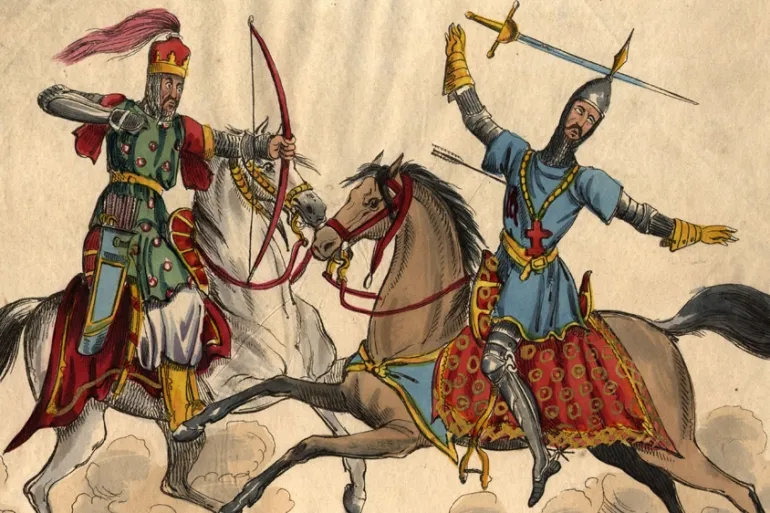
How the Crusades Changed the Relationship Between Christians and Muslims
The Crusades, a series of religiously sanctioned military campaigns spanning the 11th to 13th centuries, profoundly impacted the relationship between Christians and Muslims. This pivotal period in history not only reshaped the political landscape of the Middle East but also indelibly altered the interactions and perceptions between these two major world religions, leaving a legacy that continues to resonate in the 21st century. This article provides a comprehensive examination of the Crusades, exploring their historical context, key events, lasting consequences, and the ongoing efforts towards reconciliation and understanding.
I. The Historical Context: A Complex Tapestry of Religious and Political Motivations
The narrative surrounding the Crusades is far more nuanced than a simple clash of civilizations. While often framed as a religious war between Christianity and Islam, the reality was a complex interplay of religious zeal, political maneuvering, economic ambitions, and social dynamics. To understand the Crusades, we must delve into the multifaceted historical context that gave rise to them.
A. The Expansion of Islam and Byzantine Weakness: The expansion of Islam in the 7th century CE fundamentally altered the political and religious map of the Middle East and beyond. The conquest of previously Christian territories, including Jerusalem in 638 CE, became a powerful symbol for both sides. For centuries, a complex relationship existed between Christian and Muslim populations, marked by periods of both tolerance and conflict, often dictated by the prevailing political climate. However, by the 11th century, the Byzantine Empire, the primary Christian power in the region, faced increasing pressure from the expanding Seljuk Turkic empire, a powerful Muslim force. The Seljuks’ victories, culminating in the Battle of Manzikert in 1071, significantly weakened the Byzantines and threatened their control over Anatolia (modern-day Turkey) and their access to vital trade routes.
B. The Call to Arms and Papal Motives: The weakening of the Byzantine Empire presented a strategic opportunity for Pope Urban II. Facing internal divisions within Christendom and seeking to consolidate papal authority, he saw an advantage in uniting the disparate European powers under a common cause – the recapture of Jerusalem and the defense of Eastern Christianity. At the Council of Clermont in 1095, Urban II delivered a powerful sermon that launched the First Crusade, framing it as a holy war to liberate the Holy Land from Muslim rule. This call to arms appealed not only to religious fervor but also to the ambitions of numerous European nobles seeking land, wealth, and power. The promise of papal indulgences – remission of sins for participation – served as a powerful incentive, attracting a diverse array of participants ranging from seasoned knights to peasant pilgrims.
C. The Ideology of the Crusade: The concept of a “holy war” was not novel; religious conflicts had occurred before. However, the Crusades were uniquely shaped by the theological justifications provided by the Church. The idea of a divinely sanctioned mission to reclaim the Holy Land and convert Muslims to Christianity provided a powerful ideological framework for the campaigns. This ideology, however, often led to extreme violence and intolerance, as Christian soldiers perceived their actions as divinely ordained and justified. The concept of “Just War” theory, while attempting to provide ethical guidelines, was often selectively applied and failed to mitigate the brutality frequently displayed during the Crusades.
D. Beyond Religious Zealotry: Economic and Social Factors: The motivations behind the Crusades were not solely religious. Economic incentives played a significant role, with the promise of lucrative trade routes and access to the wealth of the East a powerful motivator for many participants. Social factors also contributed, as the Crusades offered an outlet for restless knights and landless nobles seeking adventure, glory, and opportunities for advancement. The feudal system in Europe, with its complex web of loyalties and power struggles, further contributed to the involvement of various European powers in the Crusades.
II. The Major Crusades: A Chronological Overview and Analysis of Key Events
The Crusades were not a single event but a series of distinct campaigns, each with its own unique characteristics and outcomes. Analyzing these individual crusades reveals the complex and often contradictory nature of the conflict:
A. The First Crusade (1096-1099): This crusade, while achieving the initial objective of capturing Jerusalem, also demonstrated the inherent brutality of the campaigns. The siege and subsequent massacre of Muslim and Jewish inhabitants of Jerusalem in 1099 remain a stark reminder of the violence that characterized many crusader actions. While the establishment of Crusader states in the Levant (the eastern Mediterranean region) initially consolidated Christian power, it also sowed the seeds of long-term conflict and resentment among the Muslim population.
B. The Second Crusade (1147-1149): Launched in response to the fall of the County of Edessa, a Crusader state in northern Syria, this crusade failed to achieve its objectives and further weakened the Crusader presence in the Levant. It highlighted the limitations of European power and the increasing strength of Muslim resistance.
C. The Third Crusade (1189-1192): This crusade, prompted by Saladin’s recapture of Jerusalem in 1187, witnessed the participation of prominent European figures like Richard the Lionheart and Philip II of France. While it failed to recapture Jerusalem, it resulted in a treaty that allowed Christian pilgrims access to the city. The crusade also highlighted the growing military prowess of Muslim forces under Saladin’s leadership.
D. The Fourth Crusade (1202-1204): This crusade is infamous for its deviation from its intended purpose. Instead of attacking Egypt, the Crusaders, influenced by Venetian interests, sacked Constantinople, the capital of the Byzantine Empire, in 1204. This event, a shocking betrayal of fellow Christians, had a devastating impact on the Byzantine Empire and demonstrated the political complexities and power plays inherent in the Crusades.
E. The Children’s Crusade (1212): This crusade, involving primarily children and adolescents, is a stark reminder of the powerful religious fervor that fueled the movement. Its ultimate failure underscored the impracticality of relying solely on religious zeal without adequate military and logistical support.
F. The Later Crusades (1228-1291): These campaigns, characterized by internal conflicts and shifting alliances, ultimately ended with the fall of Acre, the last major Crusader stronghold in the Levant, in 1291. This marked the end of the major Crusader presence in the Holy Land.
III. The Impact of the Crusades: Long-Term Consequences on Christian-Muslim Relations
The impact of the Crusades on Christian-Muslim relations is multifaceted and enduring. The centuries of conflict resulted in significant and lasting consequences:
A. The Rise of Muslim Resistance and Unity: The Crusades acted as a catalyst for Muslim resistance and fostered a sense of unity among disparate Muslim groups. Leaders like Saladin emerged as powerful symbols of Muslim unity against the Crusaders, effectively uniting various Muslim factions and regions against a common enemy. The repeated attacks on Muslim cities and the disruption of daily life spurred defensive strategies and innovations in military tactics.
B. The Intensification of Religious and Cultural Differences: The Crusades exacerbated existing religious and cultural differences, shaping negative stereotypes and fostering mutual distrust. The violence and brutality associated with the Crusades contributed to a narrative of Christian aggression and Muslim victimhood, perpetuating a cycle of animosity that extended far beyond the immediate conflict.
C. The Legacy of Violence and Intolerance: The numerous massacres and atrocities committed by both sides during the Crusades fostered a climate of violence and intolerance that affected subsequent interactions between Christians and Muslims. The perception of the “other” as inherently hostile or inferior became deeply entrenched, hindering opportunities for dialogue and cooperation.
D. The Development of Military Orders: The Crusades led to the emergence of powerful military orders, such as the Knights Templar and the Hospitallers, which played a significant role in the military and political dynamics of the region. These orders exerted considerable influence and power, often beyond the control of both religious and secular authorities.
E. The Impact on Trade and Cultural Exchange: While the Crusades were primarily characterized by violence, they also facilitated limited trade and cultural exchange between East and West. The exposure to new ideas, technologies, and goods, though often strained and indirect, left its mark on both Christian and Muslim societies. The transmission of knowledge and cultural artifacts, however, was often overshadowed by the overall negative impact of the conflict.
IV. The Crusades and the Shaping of Christian Identity
The Crusades played a pivotal role in shaping Christian identity and theology, leaving a complex and often contradictory legacy:
A. The Ideal of Holy War: The Crusades solidified the concept of a “holy war” within Christian theology, reinforcing the idea that violence could be justified in the defense of the faith and the recovery of holy places. This ideology influenced Christian thought and action for centuries, often used to justify conflict and oppression.
B. The Rise of Militant Piety: The Crusades contributed to a more militant and assertive form of piety, fostering the belief that military action was a legitimate expression of Christian devotion. This had profound consequences, shaping religious attitudes and leading to the justification of violence against those perceived as enemies of the faith.
C. The Development of Religious Orders: The Crusades spurred the development of new religious orders, such as the Franciscan and Dominican orders, that sought to address the spiritual and social consequences of the conflict. These orders played a significant role in promoting religious reform and fostering greater understanding between different Christian groups.
V. The Lasting Legacy and the Path Towards Reconciliation
The legacy of the Crusades continues to shape perceptions and interactions between Christians and Muslims in the 21st century. While the historical narratives often focus on conflict and violence, it is crucial to acknowledge the efforts towards reconciliation and understanding in recent times:
A. Confronting Historical Narratives: A critical examination of historical narratives surrounding the Crusades is essential for fostering genuine reconciliation. This includes acknowledging the atrocities committed by both sides, avoiding simplistic explanations, and engaging in a nuanced and balanced interpretation of the historical events.
B. Interfaith Dialogue and Cooperation: Promoting interfaith dialogue and cooperation between Christians and Muslims is crucial for building bridges and fostering mutual understanding. Joint initiatives, including collaborative projects, shared learning experiences, and public forums, can help break down stereotypes and foster mutual respect.
C. The Role of Education and Historical Awareness: Education plays a vital role in shaping perceptions and fostering understanding. By providing accurate and balanced historical information, educational institutions can equip future generations with the knowledge and critical thinking skills necessary to engage constructively with the complex legacy of the Crusades.
D. Acknowledging Shared Humanity: Emphasizing the shared humanity of Christians and Muslims is crucial for building lasting peace and reconciliation. Recognizing the common values and aspirations shared by both faiths can help overcome historical divisions and foster a shared commitment to peace and justice.
E. Moving Beyond the Past: While understanding the past is essential, it is equally important to focus on building a future of peaceful coexistence and mutual respect. Focusing on present-day challenges and working towards common goals can help overcome historical grievances and create a more inclusive and harmonious society.
In conclusion, the Crusades represent a complex and multifaceted period in history, with far-reaching consequences for Christian-Muslim relations. While the legacy of violence and intolerance remains a challenge, the ongoing efforts towards reconciliation and mutual understanding offer hope for a future where the lessons of the past are used to build a more peaceful and just world. The continued dialogue, education, and commitment to mutual respect are crucial steps in healing the wounds of history and creating a future marked by cooperation and understanding rather than conflict.


